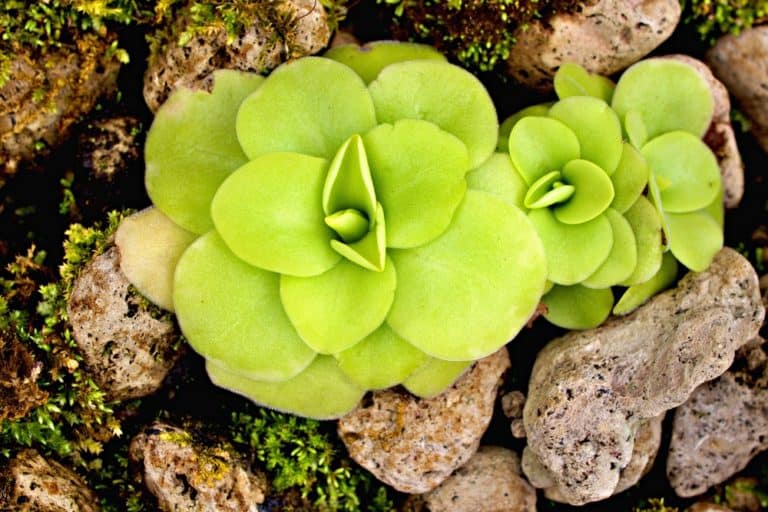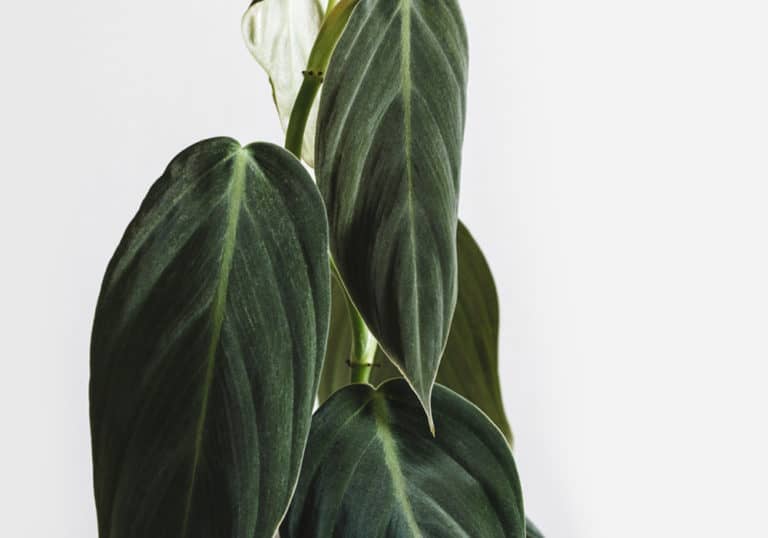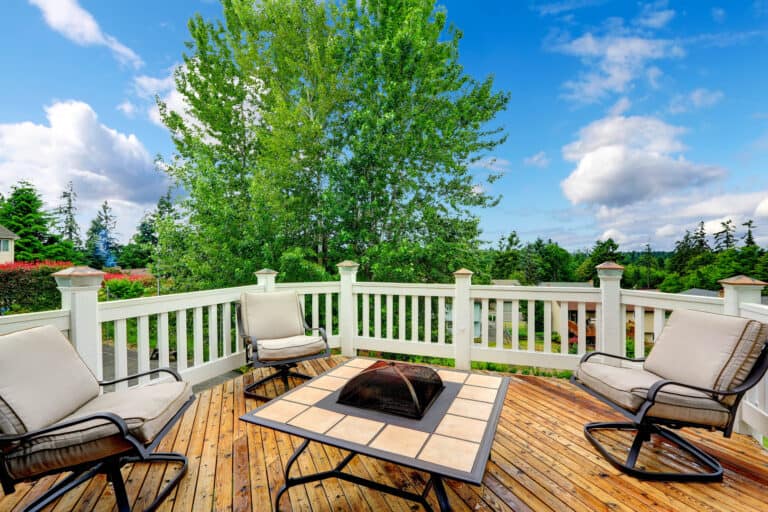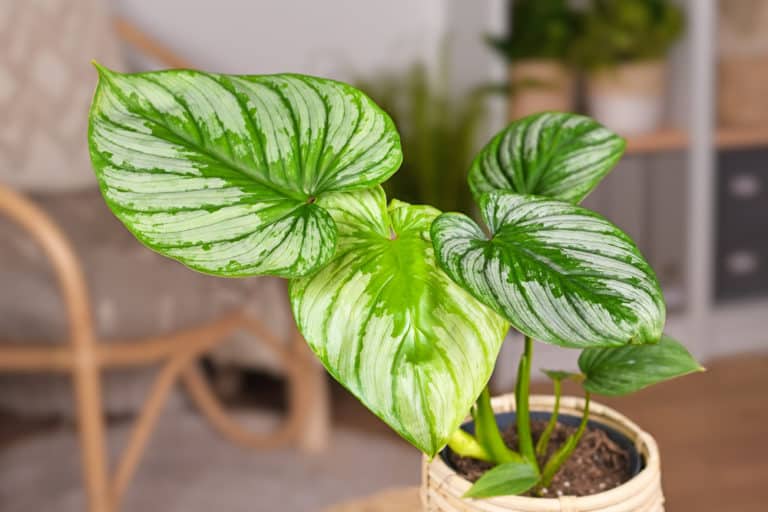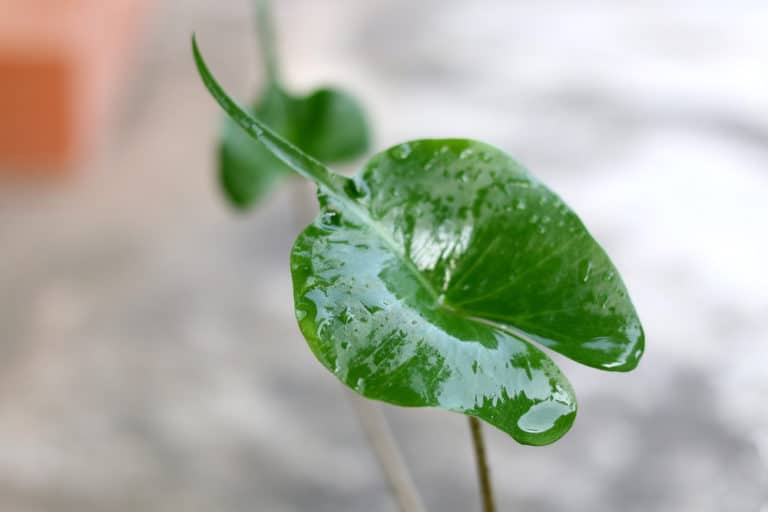Calathea Majestica ‘White star’ Care Guide (2024)

Calathea White Star can be a little fussy to grow, but its strikingly striped leaves and attractive shape make it a great project for gardeners with some experience.
While Calathea majestica ‘White star’ is similar to other Calathea cultivars, its brightly striped white and green leaves, with touches of pink, are unique.
| Scientific Name | Goeppertia Majestica |
| Common Name | Calathea White star, Zebra Plant, Prayer Plant |
| Light | Bright indirect sunlight |
| Watering | Water if the top inch of soil is dry |
| Temperature | 65°F to 80°F (18°C to 27°) |
| Hardiness Zone | 10 to 13b |
| Humidity | 50 to 60% |
| Soil Type | Rich, quick-draining, loamy |
| Soil pH | 6.0 to 6.5 (mildly acidic) |
| Fertilizing | A balanced feed once a month in spring and summer |
| Repotting | Every 1 to 2 years |
| Pruning | To remove damaged or dead leaves |
| Propagation | Root division |
| Toxicity | Not toxic to humans and pets |
| Mature Size | 4 to 5 feet as a houseplant |
| Bloom Time | Rarely blooms indoors |
What’s Unique About Calathea White Star?
The Calathea White Star plants are native to the rainforests of Brazil, where the leaves were used by natives to make baskets.
Since it was first identified in 1822, however, Calathea White Star plants have become a sought-after houseplant for their outstanding variegation. Every leaf is liberally streaked with white and pink lines.
Calathea White Star is also notable for its habit of opening and closing its leaves in response to changes in light and temperature, earning it the nickname Prayer Plant.
Growing Calathea White Star can be a little challenging, but since it’s non-toxic and purifies the air, it’s a healthy choice for your home or office.
Calathea White Star Care
Calathea White Star originates in the rainforests of Brazil, where it has evolved in tropical conditions.
As a consequence, you will need to provide some of those tropical essentials in your Calathea White Star plant care.
For good Calathea majestica care, strive to keep your plant in as warm and humid an environment as possible, with moist soil and indirect light.
Light
We tend to think of the blazing sun when we hear ‘tropical’, but in the rainforests the bright rays are filtered through the leaves of the tree canopy.
As a result, the Calathea White Star light requirements are for bright but indirect light, or between 10,000 and 15,000 lux, for 8 to 10 hours a day.
Usually, Calathea majestica light needs can be met by placing it in an east or north window.
However, if you live in a high latitude region you might need to use supplemental lighting in winter.
You can also grow Calathea White Star under the fluorescent lights common in offices.
Place your Calathea White Star out of the full sun, which can damage the leaves.
Watering
Down on the rainforest floor, Calathea White Star is used to soil that is continuously moist, while not being saturated with water.
In your home, your Calathea White Star will have similar watering needs. Never let the soil get too dry, or remain too wet.
Good Calathea White Star watering practice is to water Calathea majestica whenever the first inch of the soil is dry. Gently pour a small amount over the top just to get it moist.
Calathea White Star is very sensitive to the fluoride and chlorine in treated tap water. If you must use it, let it sit out overnight to let the chemicals dissipate.
Temperature
The Calathea White Star temperature range is 65°F to 80°F (18°C to 27°).
You should have no trouble providing a satisfactory temperature for Calathea majestica in any space where you’re comfortable.
In summer, you can move your Calathea White Star outside to let it luxuriate in hot, steamy weather for a few months.
However, indoors or out, make sure that temperatures don’t dip under 65°F (18°C), as Calathea White Star has limited temperature tolerance below that.
Keep it out of drafts and away from cold windows.
Calathea White Star has no frost hardiness, so keep your tropical perennial where it can stay toasty warm.
Humidity
Calathea White Star humidity requirements are on the high side, which is what you’d expect for a native of the steamy rainforest.
The ideal humidity for Calathea majestica is 60% or higher, although it will usually grow fine at a humidity level of 50%.
However, below that, you will start to see some signs of stress, including curling and crispy edges on the large leaves.
Misting is often recommended but is not the most effective method to keep your Calathea White Star in the humid environment it craves.
Invest in a small humidifier to keep the level up, or keep your Calathea White Star in the moister air in your bathroom.
Soil
Calathea White Star soil needs to be able to stay consistently moist, while at the same time draining any excess water to let the roots breathe.
The required pH level for Calathea majestica is 6.0 to 6.5, or mildly acidic.
A commercial African Violet soil mix is a good soil for Calathea majestica, as both of these plants have similar requirements.
However, if you prefer to make your own custom mix, combine 2 parts peat moss with 1 part perlite. You can also throw in a handful of compost or worm castings to add some nutrients to the mix.
Fertilizer
You will want to use a fertilizer for Calathea majestica to support the healthy growth of its big, beautiful leaves.
You can add slow-release granules a couple of times a season, mixing them gently into the soil.
Otherwise, use a liquid indoor plant fertilizer with a fertilizer ratio of 20-20-20.
Apply Calathea White Star fertilizer once a month in spring and summer, stopping when the plant goes dormant in fall and winter.
Dilute the fertilizer to half strength and slowly pour it over the entire soil surface.
Always apply fertilizer right after you’ve watered the soil to ensure that the nutrients don’t run through the dry soil and out the bottom.
Potting & Repotting
Calathea White Star repotting should be done every year or two.
If you see roots poking out of the bottom drainage holes, your Calathea White Star is becoming root-bound.
As well, if the leaves seem to be decreasing in size or quality, it may be time to refresh the potting soil.
When repotting Calathea majestica, don’t increase the pot size unless the roots have filled the current pot. Always ensure it’s got drainage holes.
Even if you do need to go to a bigger pot, only go up one size, as too much space can actually set the growth of your Calathea White Star back.
Pruning
You won’t need to do much Calathea White Star pruning.
For the most part, you will only be cutting Calathea majestica to remove dead or damaged leaves. Do this whenever it is necessary during the year.
To remove an entire leaf, cut the stem at soil level, using a sterilized knife or scissors.
However, you may not need to take out the whole leaf if it is only slightly damaged, especially around the edges.
It’s possible to use sharp scissors to carefully trim off brown tips or edges, keeping your Calathea White Star looking its best without sacrificing a whole leaf.
Propagation
Calathea White Star propagation is easy to do whenever you repot your plant.
The only way to propagate Calathea majestica is through root divisions, done in the spring at the beginning of its growing season.
After watering the soil thoroughly, remove the root ball from its pot. You should be able to see new separate plants growing around the edges of the mother plant.
Gently tug the roots apart, making sure each new plant has both stems and roots. You may need to use a sharp, sterilized knife to help.
Then, plant out each new baby Calathea White Star plant in its own pot.
Also, make sure to check out our in-depth Calathea burle marx plant care guide.
Common Problems of Calathea White Star
There is more potential for problems with Calathea majestica than with other houseplants.
Calathea White Star problems often stem from the moist conditions in which it thrives. Unfortunately, often bugs and diseases also appreciate a damp environment.
Keep an eye on the leaves of your Calathea White Star, as they will give you the first indication that there’s a problem that needs to be resolved.
Pests
Calathea White Star pests can cause serious damage to your plant.
The best way to deal with bugs on your Calathea majestica is to stop them first.
When you wipe down your Calathea White Star leaves, add insecticidal soap or neem oil to the mixture.
However, you may still find some insects.
Fungus gnats thrive in damp soil. You will see little black flies hovering around the soil. Use yellow sticky traps to capture adults. Then, apply a mixture of 4 parts water with 1 part hydrogen peroxide to kill eggs and larvae.
Scale insects can be found as small brown bumps on the stems or under the leaves. Rub them with a cotton swab dipped in rubbing alcohol.
Diseases
Calathea White Star diseases can be fungal or bacterial, and usually stem from too-wet soil or foliage.
To keep your Calathea majestica as healthy as possible, don’t let the leaves stay wet, and use a well-draining soil mix.
Alternaria leaf spot manifests itself as small, wet-looking reddish-brown spots.
Septoria leaf spot is a fungal disease that turns leaves yellow and brown as they die.
Root rot will first be obvious when leaves turn yellow and the stems get mushy. If you examine the roots, you will find that some of them have turned black and soft, with a foul smell.
For these and all other diseases, cut out all infected parts, and repot your Calathea White Star in fresh potting soil in a new or disinfected pot.
Growing Problems
Other growing problems don’t require killing bugs or curing diseases.
Your sick plant may just need improved growing conditions.
Faded or browning leaves probably mean that your Calathea White Star is getting too much sun. Move it to a shadier spot, or hang a thin curtain to filter the bright rays.
Brown leaf tips can indicate low humidity levels, or too much fertilizer. You can flush out excess fertilizer by running a steady stream of water through the soil for about 10 minutes.
Wilting leaves can also be a sign that you need to increase the humidity level around your Calathea White Star.
Toxicity of Calathea White Star
Calathea majestica is not at all toxic to animals or humans.
Because it has no toxicity, Calathea White Star can safely be grown in households that also contain children and pets.
However, it’s still a good idea to keep the small members of your household away from all your plants.
For Humans
Because Calathea White Star is not toxic to humans, you can include it in your tropical garden without fear that it will trigger a life-threatening reaction in children.
However, there are a few reasons why you should still exercise some caution in growing these plants around children.
You may be using insecticides or fungicides to control pests or diseases on your Calathea White Star. Obviously, you will not want to expose your children to these, even if they are organic.
As well, a child should learn to treat all houseplants with respect, as they will not distinguish between safe and dangerous plants.
Finally, you certainly don’t want your child to damage your Calathea White Star.
For Pets
Calathea White Star is not at all toxic to animals, so it is safe to grow with pets in the household. You shouldn’t need to go to extreme lengths to separate the two.
However, cats and dogs are carnivores by nature. Their digestive systems have evolved to handle meat, so if they chow down on your Calathea White Star, they could end up suffering from gastro-intestinal upsets.
That means vomiting and diarrhea. It’s certainly not life-threatening, and you won’t need to rush your furry friend to the vet, but it will definitely be unpleasant for all concerned while it lasts.
Calathea White Star Appearance
The Calathea White Star appearance is nothing short of spectacular.
Its leaves, liberally streaked with shades of white, green, and pink, put on a fabulous show year-round.
The Calathea majestica flower isn’t going to put in an appearance on a potted plant, but the foliage is so stunning, you will not miss it.
Foliage
The foliage of Calathea White Star features distinctive variegation that will make it a stand-out in any indoor setting.
Each leaf can grow to 16 to 18 inches long, and 4 to 5 inches wide.
They have many white stripes, looking as if they’re hand-painted, sloping out on the diagonal from the green center rib.
On some of the leaves they also have a pink blush for added color, all against a green backdrop.
The underside of each leaf is a deep purple, to add even more color depth.
These thick, waxy leaves will last for months, so wipe them regularly to keep them looking their best.
Flowering
Calathea White Star flowering is basically not possible when it’s grown indoors as a potted plant. Blooming is only going to occur on a plant growing outdoors in a tropical zone.
However, there is no need for flowers when you’ve got such stunning evergreen foliage to enjoy on your Calathea White Star.
Still, one of the great things about houseplants is that you can never have too many. If you really want a flowering Calathea, you could buy a C. crocata to grow alongside your Calathea White Star.
Its ruffled foliage is nowhere near as attractive as Calathea White Star, but it does reliably produce beautiful orange flowers.
Size and Growth
The size of Calathea White Star is a perfect fit for most homes or offices.
With a moderately fast growth rate, it will take a few years to reach its full height of 4 to 5 feet, with a spread of 1 to 2 feet.
The stems grow up from the plant crown, each with one long, narrow leaf. The stems stay erect but arch out for an elegant look.
It does not require any staking to maintain its upright shape.
A small Calathea White Star can be kept in a pot on a table or ledge, but when it reaches its full height you will want to keep it at floor level.
Calathea White Star Fragrance
There is no Calathea White Star fragrance. Even when it does bloom, which only happens in tropical zones, the flowers have no scent.
The foliage has no fragrance either.
However, Calathea White Star has a very positive impact on the air in your home or office. Like all Cathatheas, it filters harmful chemicals such as formaldehyde from the air.
As well, in public spaces such as offices and stores, unscented plants are preferable because some people have sensitivities to fragrances.
Because the foliage is so outstanding, the lack of scent should not deter you from adding Calathea White Star to your indoor garden.
Suggested Uses for Calathea White Star
Even though it’s been a popular house plant for a long time, Calathea White Star is perfect for even the most modern loft or office space.
The variegated lines on the leaves have a timeless appeal.
It’s also possible to fit Calathea White Star into even a small indoors setting, as it doesn’t take up a big footprint. With a spread of only 2 feet at most, you can use it even in a small city apartment.
Feel free to move your Calathea White Star outside to a shady spot on your balcony or patio in summer, where it will love the extra heat and humidity.
FAQ
What is Calathea White Star?
Calathea White Star is a native of the tropical and subtropical rainforests of Brazil, where it grows as an understory plant. It is commonly grown as a houseplant.
How to identify Calathea White Star?
Calathea White Star has long, narrow leaves with a thick waxy texture, with a pattern of narrow white and pink lines slanting out from the center rib.
How to care for Calathea White Star?
Calathea White Star needs to be grown in consistently moist but well-drained soil, in warm humid conditions and kept in bright but filtered or indirect light.
How to grow Calathea White Star indoors?
Calathea White Star can be grown indoors in a warm, humid environment, kept out of the full sun and watered regularly to maintain moist soil.
How to grow Calathea White Star outdoors?
Calathea White Star can be grown outdoors in the ground year-round in zones 10 to 13b, or brought outdoors in hot summer weather in temperate zones.
How fast does Calathea White Star grow?
Calathea White Star has a moderately fast growth rate, taking a couple of years to reach its mature size of 4 to 5 feet tall.
How tall does Calathea White Star grow?
Calathea White Star has the potential to reach a height of 4 to 5 feet with a spread of 1 to 2 feet when grown indoors as a potted plant.
How to make Calathea White Star grow faster?
Calathea White Star will grow its fastest when grown in warm to hot temperatures, and as high humidity as possible, with regular watering and fertilizing.
How to stake Calathea White Star?
Calathea White Star naturally grows erect, so there is no need to stake your plant. Rotate the pot a quarter turn every week to ensure that it does not lean in one direction.
How to pot Calathea White Star?
Calathea White Star should be potted in a soil mix that will retain moisture while still draining away excess, in a pot with drainage holes.
How to revive Calathea White Star?
If your Calathea White Star is showing signs of stress, it may be in too cold an environment. Bring it into a warmer room and raise the humidity level.
Why is my Calathea White Star dying?
Your Calathea White Star may have a fungal or bacterial disease due to overly wet conditions. Cut away all affected parts and repot in a fresh soil mix.
Why is my Calathea White Star drooping?
Your Calathea White Star may be drooping because it is too wet or too dry. Either water it thoroughly, or take it out of its wet soil and replant it in fresh soil.
How cold can Calathea White Star tolerate?
Calathea White Star will not grow well below 65°F (18°C), so keep it out of drafts and away from cold windows. It will die if exposed to freezing temperatures.
How to get rid of pests on Calathea White Star?
Keep pests off your Calathea White Star by wiping the leaves down regularly with a cloth dampened with neem oil or insecticidal soap solution.
Is Calathea White Star toxic to cats?
No, Calathea White Star is not toxic to cats. However, cats can have intestinal issues if they eat too much vegetable matter, so discourage them from eating it.
Is Calathea White Star toxic to dogs?
No, Calathea White Star is not toxic to dogs. However, your dog could experience vomiting and diarrhea if they eat too much of the foliage because they cannot properly digest it.
Is Calathea White Star toxic to children?
No, Calathea White Star is not toxic to children. However, you may use sprays on your plants that they could have a reaction to, so keep them away from all plants.
Is Calathea White Star toxic to humans?
No, Calathea White Star is not toxic to humans. You can expect to have no adverse reactions to any part of the plant, including the sap.
Does Calathea White Star have a scent?
No, Calathea White Star has no scent. Neither the extremely rare flowers nor the foliage has any fragrance, so these plants can be used anywhere without fear of allergic reactions.

